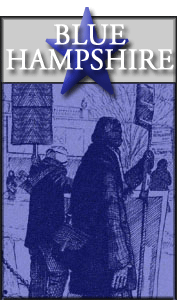|
Gallup's generic congressional ballot survey, in which voters are asked whether they intend to vote for the Republican or the Democratic candidate in their district, has proven to be an accurate predictor of the eventual vote in midterm elections. But to avoid the risk of basing the model on a a single outlier poll, I chose to average all the generic ballot polls recorded by Pollster.com in the past 30 days, after first screening for those using a “likely voter” model and weighting each poll based on age. The result projects a 53.1% – 46.9% advantage for Republicans in the national congressional vote.
I adjust the probability of a partisan outcome for each district based on this projection and run 100,000 simulations. The resulting forecast says there is a 95% chance that Republicans will win 259 – 287 seats in the 400-seat chamber and take back the majority.

Clearly a national Republican wave presents a fundamental challenge for State House Democrats. For reference, this 6-point GOP advantage is comparable to 2002, when Republicans won the national two-party congressional vote by a 52.4% – 47.6% margin and won 282 State House seats. But while there are structural reasons why we can anticipate the New Hampshire State House vote will mirror the national vote, I can also suggest a few reasons why the results might not be so dire.
The Lynch Effect – Gov. John Lynch has consistently outperformed national Democrats. Jamie Shufflebarger points out voters focus on gubernatorial races “because state policy matters affect their pocketbooks more” and a strong gubernatorial turnout operation can make a significant difference in down-ticket races.
Demographic Changes – Cook’s PVI calculations confirm that when compared to the rest of the nation, New Hampshire voters are becoming more Democratic. This model assumes a partisan makeup based on the 2004 and 2008 election results. Subsequent demographic changes could increase the 2010 Democratic vote share.
Voter Enthusiasm – Polls of registered voters have shown a fairly even spilt between Republicans and Democrats. It’s when the surveys screen for likely voters that Republicans open up a big lead. If, in the end, Democratic turnout matches Republicans, the Republican advantage will shrink.
GOTV – Research shows that multiple contacts from a campaign can increase turnout by 10-14 percentage points. This model makes no effort to measure local GOTV efforts, but if this year’s Democratic GOTV program outperforms the GOP effort, the numbers will shift.
A Moving Target – Even the most accurate poll is a snapshot in time, a measurement of public opinion at the time of the survey. Elections have a natural tendency to tighten as election day nears. We may yet see Democrats lessen the gap with Republicans before election day.
And then there's whole cell phone thing. You get the point.
Cross-posted to Miscellany Blue
|


